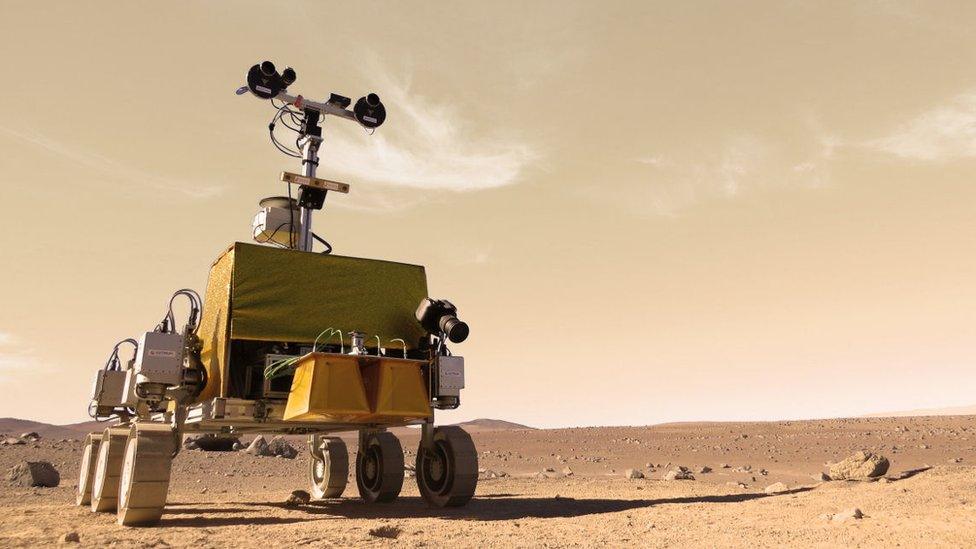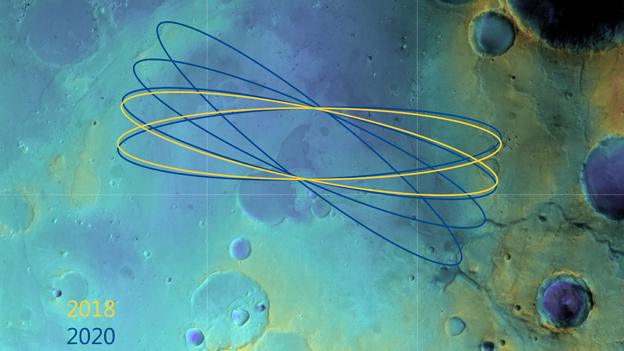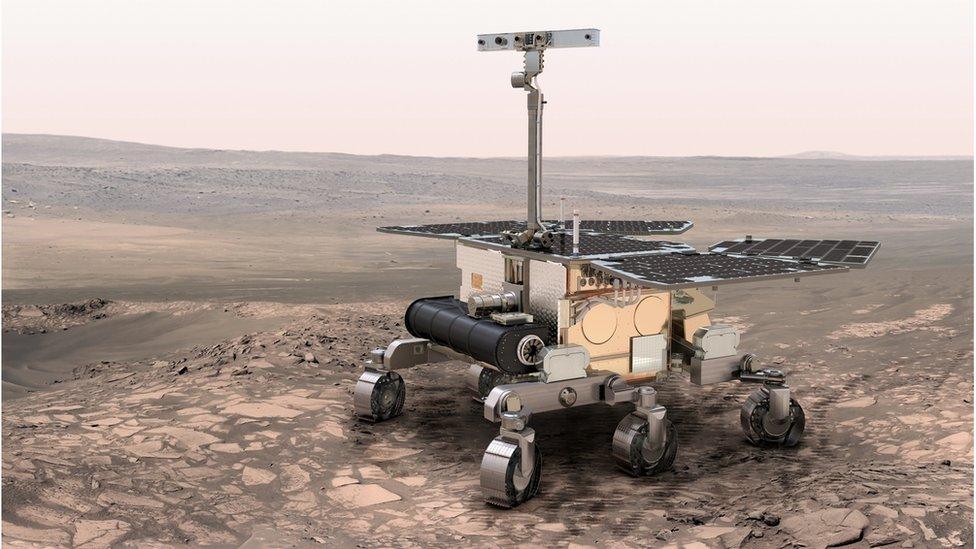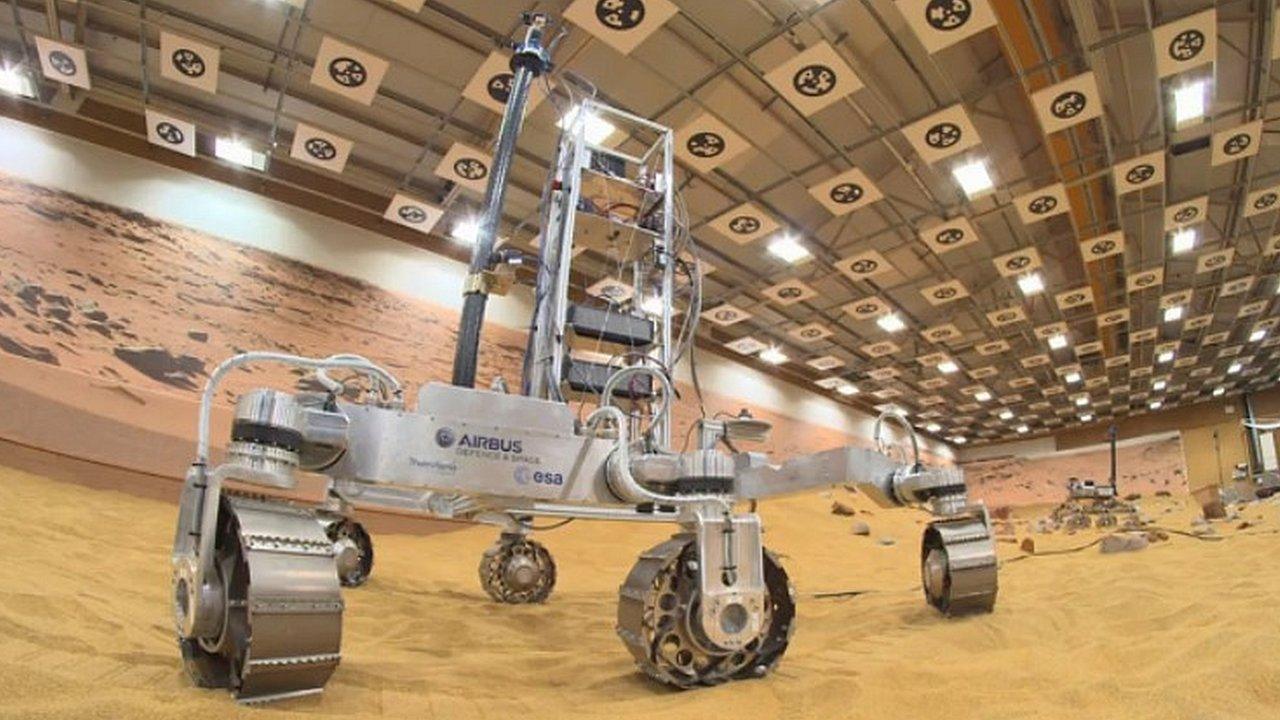ExoMars rover: Landing preference is for Oxia Planum
- Published

Industry has built models to test the technologies needed on ExoMars
The robot rover that Europe is building to send to Mars is likely to be targeted at an equatorial region known as Oxia Planum.
It is an area rich in clays and other minerals that have resulted from prolonged rock interactions with water.
The European Space Agency's ExoMars vehicle will carry a suite of instruments to look for signs at Oxia of past or even present life.
The launch of the mission from Earth is currently scheduled for 2018.
However, if the hardware cannot be prepared in time - and there is some doubt that it can be - then the departure will occur in 2020.
If that is the case then scientists and engineers will also consider two other locations - Mawrth Vallis and Aram Dorsum.
The rating of the competing destinations follows two days of debate inside the ExoMars Landing Site Selection Working Group (LSSWG), external.
Oxia Planum, which is said to enjoy strong support across the group, is now regarded as the "primary candidate".

The location will be subjected to further strenuous analysis, not just to better understand its scientific credentials but also to determine its engineering suitability.
Mission managers have to be sure that the rover can get down safely using its system of parachutes and rockets.
To win final approval, Oxia will need to have an area of terrain roughly 100km by 15km (the ellipse of error expected with the landing system) that is largely free from fissures, excessive slopes and large boulders.
The US space agency (Nasa) will help determine whether this is so by imaging Oxia with the high-resolution camera on the Mars Reconnaissance Orbiter.
Commenting on the selection, ExoMars project scientist Dr Jorge Vago said: "Oxia Planum has the lowest elevation of the sites, which from an engineering point of view gives you an extra level of confidence (because it affords more time for the parachutes to slow the descent).
"And in terms of rockiness and slopes - what we have seen so far appears to be all right.
"Nasa have been great. They've been giving us plenty of MRO images, and for the 2018 launch opportunity we have already pretty good coverage; in some cases up to 40-50% of the ellipse."
For a 2018 launch, confirmation of ExoMars' target destination should come in late 2017.
A fourth candidate - Hypanis Vallis - was dropped by the LSSWG from consideration for both the 2018 and 2020 scenarios.

The Martian contenders

To find signs of ancient or even present-day life, ExoMars will need to go to a region that shows evidence of having been in contact with water
In the main, this means visiting a location that is really ancient - and all the sites retain rocks that are more than three billion years old
Oxia Planum (above) is rich in clays minerals, and contains features that appear to have been shaped by river action and by deltas
Mawrth Vallis contains even thicker deposits of clays but its northerly latitude makes it hard to reach safely on a 2018 flight
Aram Dorsum contains a large channel. The sedimentary rocks around this channel may well be the consequence of flood deposits
ExoMars will not have the sterility rating required to visit "special regions" suspected of hosting liquid water at, or near, the surface today

Dr Peter Grindrod is a Mars specialist with the UK Space Agency and Birkbeck, University of London.
After the LSSWG meeting, he told BBC News: "One of the most exciting things we've heard about all of the final sites is that, although they each have slightly different geological features and histories, it seems that they might all be linked in a broader sense.
"The sites all have access to some of the oldest rocks that show evidence of water being present, which could have formed early in the history of Mars when conditions were possibly more favourable for life.
"With all sites being relatively close together on the planet, it's reassuring that ExoMars in Oxia Planum will tell us about the bigger picture of the history of the area, in addition of course to addressing the question of life."
Russian rescue
The ExoMars project has been a long-drawn-out affair, subjected to various programmatic changes and delays.
It came very close to collapse in 2012 when Nasa scaled back its involvement, and was only saved when Russia agreed to pick up key elements of the mission.
These include the provision of a rocket to send the rover on its way and the design for a landing system.
Currently, space agency officials are in negotiation with industry for the contract to fabricate the flight hardware - what is known as a Phase C/D contract.
This is taking longer than expected, in part because of uncertainty over the build and integration schedule.
Component ballet
The various components of the mission - including the rover (UK), its instruments (Italy), the landing system (Russia) and the cruise ship that takes everything to Mars - must all fit into a complex sequence of assembly and testing.
If this sequence can be agreed and made to work, the mission will be sitting atop its Proton rocket at the Baikonur cosmodrome in Kazakhstan in May 2018, for a launch that would lead to a landing at the chosen site eight months later.
If industry cannot meet the schedule, the whole venture will slip by two years to an August 2020 launch (landing in April 2021).
The two-year bounce is a consequence of Mars' and Earth's alignment: they are only in optimal positions in their orbits to support a flight opportunity once every 26 months.
An industry "tiger team" is presently trying to figure out solutions to the scheduling problems, to maintain the 2018 option.

ExoMars rover and satellite relay

The rover will have a suite of instruments and a drill to go below the surface
It should work for a minimum of seven months, but hopefully much longer
Europe and Russia lead the project, but the Americans are also involved
The US will provide a telecoms relay, to be launched on an orbiter next year
This satellite (below) will also study the atmosphere of the Red Planet
It has a lander, too, designed to test radar and guidance technologies
These systems will be critical to the safe landing of the rover in 2019/2021


Jonathan.Amos-INTERNET@bbc.co.uk, external and follow me on Twitter: @BBCAmos, external
- Published1 October 2014

- Published27 March 2014
- Published27 March 2014

- Published12 October 2013
- Published21 June 2013